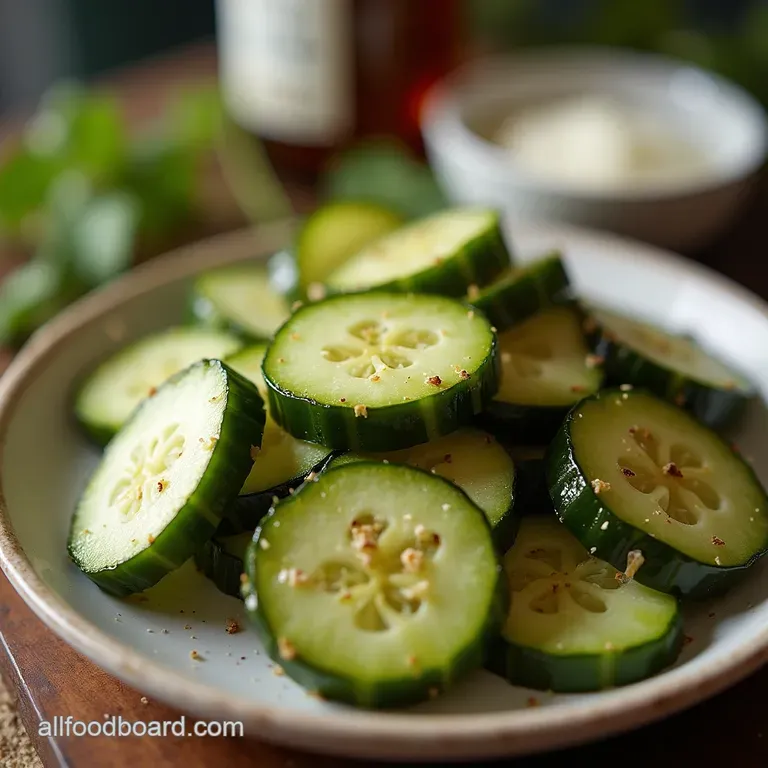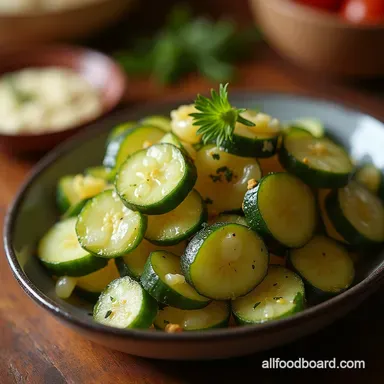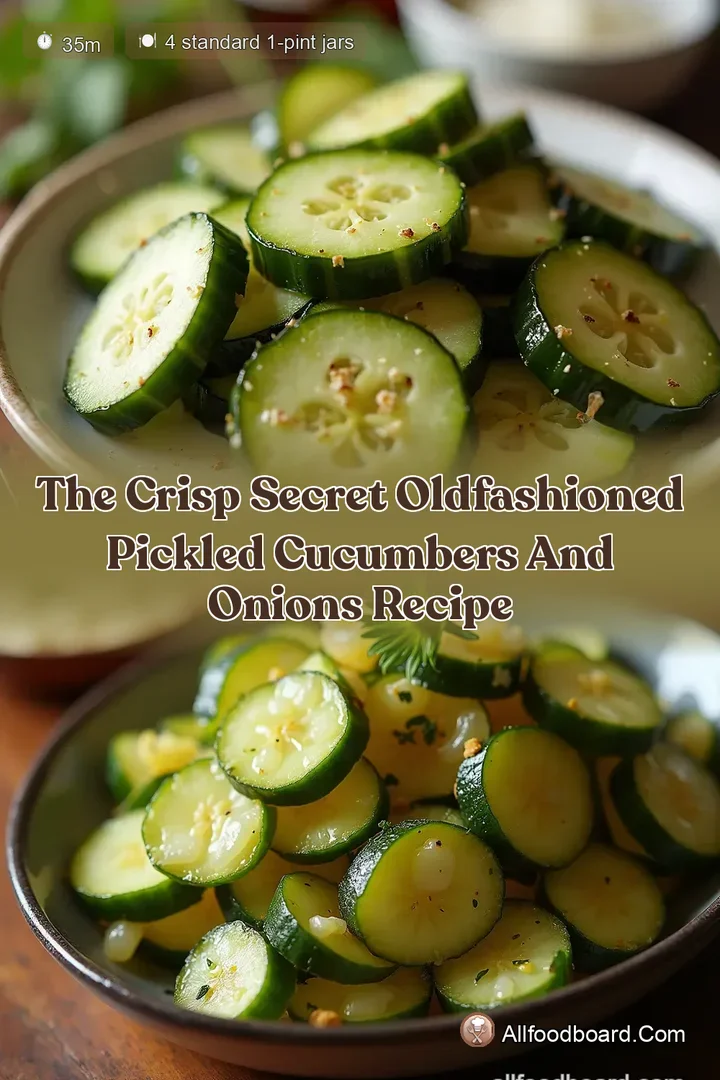The Proper Crunch Classic HomeStyle Pickled Cucumbers and Onions

- Unlocking the Authentic Taste of Tradition: Our Old-Fashioned Pickled Cucumbers and Onions
- Why This Classic Brine Recipe Reigns Supreme
- Assembling Your Brine Components for Perfection
- The Essential Toolkit for Perfect Preserving
- The Step-by-Step Guide to Crafting Superior Old-Fashioned Pickled Cucumbers and Onions
- Maximizing Flavor and Longevity: Storage and Serving Secrets
- Recipe FAQs
Classic Pickled Cucumbers Onions

Ingredients:
Instructions:
Nutrition Facts
Unlocking the Authentic Taste of Tradition: Our Old-Fashioned Pickled Cucumbers and Onions
There is an undeniable magic that happens when humble cucumbers and onions are transformed by a sharp, perfectly balanced brine. Right then, pull up a chair! There’s nothing quite as satisfying as a proper, crisp pickle, is there? It brings a bit of that classic seaside chippy flavour right to your kitchen counter. We’re going back to basics with these Old-Fashioned Pickled Cucumbers and Onions —a true taste of tradition that requires minimal fuss but delivers maximum crunch. Forget those sad, watery supermarket jars! This recipe delivers perfectly crisp, tangy, and slightly sweet pickled vegetables, steeped in a vibrant vinegar solution seasoned with classic pickling spices. It’s the ideal accompaniment for everything from ploughman’s lunches and hearty Sunday roasts to a simple cheese and pickle sandwich.
Why This Classic Brine Recipe Reigns Supreme
This particular approach is classified as Easy in terms of execution, relying almost entirely on precise measuring and heating of the pickling liquid rather than complex fermentation techniques. We aim for a quick pickle that delivers exceptional depth of flavour, perfect for serving within a couple of days. This blueprint for crafting the perfect batch yields approximately four standard 1-pint (500ml) jars and requires only about 35 minutes of active time, though patience during the chilling phase is non-negotiable for optimal results.
The Return to Real Crunch: What Makes These Pickles Essential
The secret weapon in achieving that essential, satisfying snap lies in the pre-treatment of the vegetables. Before they ever meet the hot liquid, the thinly sliced cucumbers (Kirby or mini gherkins work wonderfully) and red onions must spend 30 minutes mingling with coarse kosher salt. This process, known as drawing out moisture, is absolutely crucial; it dehydrates the vegetables slightly, preventing them from turning soft and spongy once submerged in the vinegar solution.
A Heritage Recipe: Capturing That Seaside Chippy Nostalgia
This Old Fashioned Pickled Cucumber and Onion Salad Recipe captures a flavour profile deeply rooted in comfort food history. The specific combination of spices used—mustard seeds, celery seeds, turmeric for colour, and whole peppercorns—creates that familiar sharp, salty, and just-a-whisper-of-sweet warmth you associate with old-school deli counters. When you combine these elements, you are recreating the essence of Grandma's Old Fashioned Pickled Cucumbers and Onions .
Beyond the Jar: Setting Expectations for Superior Tang and Snap
It is important to note that this recipe leans toward a tangier profile. For those who specifically seek a less sweet experience, this format naturally aligns well with an Old Fashioned Pickled Cucumbers and Onions No Sugar approach, although our base recipe includes sugar for balance. The resultant flavour balances sharp vinegar acidity with a delicate sweetness, ensuring the tang hits first, followed by the savoury spice notes.
Assembling Your Brine Components for Perfection

Creating a perfect pickle depends entirely on the integrity and ratio of your liquid components. For this Old Fashioned Marinated Cucumbers and Onions , we use a specific blend designed for maximum flavour penetration during the short steep time. The brine base requires two parts white distilled vinegar (must be 5% acidity) mixed with one part water. To this, we add 1 cup (200g) of granulated sugar to temper the vinegar’s harshness, yielding that quintessential slightly sweet tang. The spice blend is non-negotiable: 1 tablespoon of mustard seeds, 1 teaspoon of celery seeds, 1/2 teaspoon of turmeric powder for that classic golden hue, and 1 teaspoon of whole black peppercorns.
Related Recipes Worth Trying
- The Ultimate Crispy Egg and Rice Patties Recipe Leftover Rice Hero — Transform your leftovers Learn how to make surprisingly delicious Crispy Egg and Rice Patties with a gooey yolk centre An absolute smashing weeknight recipe
- Ultimate Cheesy Broccoli and Rice Casserole Recipe — Forget dry bakes This Easy Cheesy Broccoli Rice Bake uses a homemade Mornay sauce for a truly gooey comforting finish Perfect family dinner casserole
- Easy Slow Cooker Chicken and Dumplings Recipe for Dinner — Forget faffing about This Easy Slow Cooker Chicken and Dumplings recipe delivers a proper hug in a bowl with fluffy homemade dumplings on top Get the full...
The Essential Toolkit for Perfect Preserving
To successfully execute the Pickles Cucumbers And Onions process, you need a few fundamental tools. Sterilised jars are paramount for food safety and longevity. You will require four clean 1-pint (500ml) Mason jars, equipped with tight-fitting lids. Beyond that, you’ll need a large colander, a non-reactive saucepan (stainless steel is ideal to avoid chemical reactions with the vinegar), and your precise measuring instruments.
Selecting Cucumbers for Maximum Crispness (Gherkins Welcome!)
The ingredient prep starts with your primary vegetable. Select small pickling cucumbers, often labelled as Kirby or miniature gherkins, as they have fewer seeds and a thicker flesh structure ideal for crunch retention. Slice these thinly, about 1/8 inch (3mm) thick. We pair these with two medium Old Fashioned Pickled Cucumbers and Red Onions , sliced into clean half-moons.
Measuring the Vinegar, Sugar, and Spice Ratios Precisely
Adherence to the brine ratios is critical. Too much water dilutes the preserving power of the vinegar, and too much sugar can result in a syrupy texture rather than a crisp marinade. Stick strictly to the 2 cups of vinegar to 1 cup of water ratio, balanced by 1 cup of sugar. The celery seed and mustard seed must be measured accurately, as they carry the bulk of the traditional pickle flavour profile.
Required Vessels: Jars, Pots, and Tools for the Batch
Ensure your jars and lids are properly sterilised before you begin filling them—either by running them through a hot dishwasher cycle or by simmering them in water for 10 minutes. This step is especially important if you are letting the pickles rest for longer than a week in the refrigerator, as it establishes a clean environment for the contents.
The Step-by-Step Guide to Crafting Superior Old-Fashioned Pickled Cucumbers and Onions
The journey from raw vegetable to tangy delight is surprisingly swift once the prep work is done. The active process primarily involves drawing out moisture, preparing the hot liquid, and then combining the two elements before cooling.
Prepping Your Produce: Washing, Slicing, and Layering Techniques
Begin by tossing your 1.5 lbs of sliced cucumbers and onions together with 2 tablespoons of coarse kosher salt in that large colander set over a bowl. Let this mixture sit undisturbed at room temperature for a full 30 minutes. After the resting period, rinse the vegetables very thoroughly under cold running water to eliminate all residual salt. Drain them completely, pressing gently to squeeze out any last traces of excess liquid—this is your insurance policy for a fantastic crunch.
The Quick Simmer: Bringing the Sweet and Sour Liquid to Temperature
While the vegetables are draining, combine your vinegar, water, sugar, and all the dry spices (mustard seeds, celery seeds, turmeric, peppercorns) in the non-reactive saucepan. Heat this mixture over medium-high heat, stirring constantly until the sugar is completely dissolved. The moment it reaches a rolling boil, remove it immediately from the heat source. No lengthy cooking is needed; we are just dissolving the solids.
The Critical Cooling Phase: Ensuring Shelf-Stable Seal
Now, assemble the jars. Divide the rinsed and well-drained vegetables evenly among your prepared, warm jars. If you desire extra depth, this is when you add optional flavour enhancers like a fresh sprig of dill or a peeled garlic clove to each jar. Carefully pour the hot brine over the vegetables, ensuring everything is submerged and leaving about 1/2 inch (1.25 cm) of headspace at the top rim. Gently tap the sides of the jars to encourage any trapped air bubbles to surface and escape. Seal the lids tightly. Allow the filled jars to sit undisturbed on the countertop until they reach room temperature, which usually takes one to two hours.
Maximizing Flavor and Longevity: Storage and Serving Secrets
Once cooled to room temperature, the next phase of flavour development begins. Transfer the sealed jars directly into the refrigerator.
Patience Pays Off: How Long to Wait Before Tasting Your Creation
While you might be tempted to sample immediately, the best flavour penetration for this Old Fashioned Pickled Cucumber and Onion Salad Recipe is achieved over time. We strongly recommend waiting a minimum of 24 hours before tasting, though 48 to 72 hours allows the spices and vinegar to fully permeate the vegetables, delivering the most robust results.
From Fridge to Table: Optimal Storage Guidelines for Brined Goods
Since this recipe focuses on refrigerator pickles rather than shelf-stable canning, these vibrant pickles must be stored in the cold. Properly refrigerated, they will maintain excellent quality and crunch for up to two months.
Spice Profile Adjustments: Adding Heat or Herbaceous Notes
If you prefer a slightly hotter pickle, consider adding 1-2 dried whole red chillies directly into the brine mixture before heating. For an Old Fashioned Sweet Pickled Cucumbers and Onions variation, you can increase the granulated sugar in the brine to 1.5 cups, though this slightly softens the overall texture profile.
Pairing Suggestions: What Eats Best Alongside Your Tangy Relish
These pickles are incredibly versatile. They are non-negotiable alongside a hearty Ploughman’s lunch—think mature cheddar and crusty bread. They also provide a vital acidic counterpoint to rich foods, making them the ultimate burger topping or a fantastic, bright accompaniment to smoked fish or cold cuts. Even their smallest slices make sophisticated, flavour-packed garnishes for cocktails.

Recipe FAQs
Can I skip the initial salting step for the Old-Fashioned Pickled Cucumbers and Onions? I'm short on time.
Hold your horses! While it might seem like an extra faff, skipping the initial salt bath is the number one way to end up with floppy, soggy pickles. That salt draws out the excess water, which is the secret to that satisfying, proper crunch you're after. For best results, give them that 30-minute rest!
How long do these refrigerator pickles actually keep once they are made?
Since this recipe focuses on quick refrigerator pickles (not shelf-stable canning), they should be stored in an airtight container in the fridge. They are best eaten within 4 to 6 weeks for peak flavour and texture. If they start to look cloudy or smell off, it’s time to chuck them—no point risking it!
My brine looks a bit pale; can I make my Old-Fashioned Pickled Cucumbers and Onions more yellow?
Absolutely, you can give them that classic golden hue often seen in traditional recipes! The turmeric powder is there specifically for colour, so if you want them brighter, just bump that measurement up to a full teaspoon. Just be careful not to add too much, or you might end up with a slightly earthy flavour that isn't quite what we’re aiming for.
Can I use Apple Cider Vinegar instead of white distilled vinegar?
Yes, you certainly can substitute it, but do be aware that the flavour profile will shift slightly. Apple Cider Vinegar (ACV) adds a subtle fruitiness and a touch of cloudiness to the brine compared to the crystal clarity you get from distilled white vinegar. If you do use ACV, ensure it is still 5% acidity, or your pickles might not be tart enough.
What’s the best way to make sure the onions stay crunchy and don't get mushy?
Onions can soften quicker than cucumbers, so two things will help: firstly, slice them relatively thinly, as directed in the recipe. Secondly, ensure you use enough salt when drawing out the moisture, and rinse them very thoroughly afterwards. The boiling hot brine will slightly soften them, but proper prep ensures they maintain a nice bite.